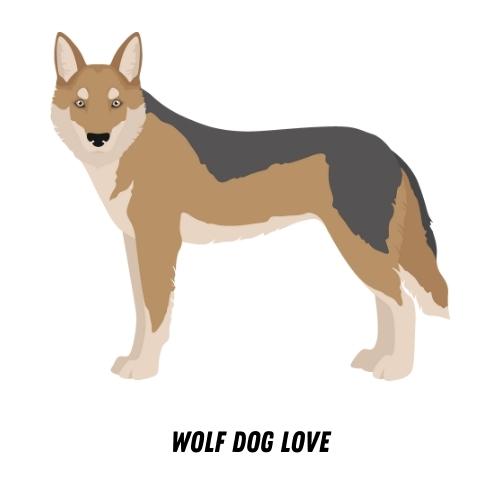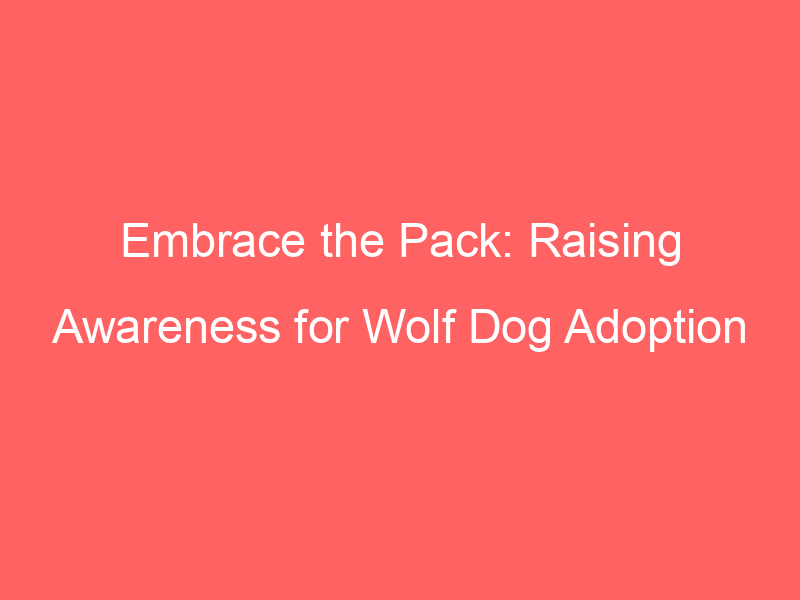Introduction to Wolf Dog Behavior
Wolf dogs are fascinating creatures, a unique blend of domestic dog and wild wolf. Understanding their behavior is key to fostering a harmonious relationship with them. In this section, we will delve into the nature of wolf dogs and dispel some common misconceptions about them.
- Understanding the nature of wolf dogs
- Common misconceptions about wolf dogs
Wolf dogs, as their name suggests, are a mix of wolves and dogs. They possess traits from both parents, making their behavior a blend of domestic and wild. Wolf dogs are intelligent, independent, and energetic. They require plenty of mental and physical stimulation to keep them happy and healthy. They are also pack animals, which means they thrive in a family environment and need a strong leader to guide them.
There are many misconceptions about wolf dogs, largely due to their wolf heritage. One common myth is that wolf dogs are aggressive and dangerous. In reality, wolf dogs are not inherently aggressive. Like any other dog, their behavior largely depends on how they are raised and trained. Another misconception is that wolf dogs are wild animals and cannot be domesticated. While they do have wild instincts, wolf dogs can adapt to living with humans if properly trained and socialized.
In the following sections, we will delve deeper into understanding wolf dog behavior, how to foster wolf dogs, and how to ensure peaceful coexistence with them. We will also discuss suitable homes for wolf dogs, how to maintain harmony in pet homes, wolf dog training, cohabitation, and peaceful living.
Understanding Wolf Dog Behavior
Wolf dogs are unique creatures that exhibit behaviors from both their wolf and dog ancestors. Understanding their behavior is key to fostering a healthy and harmonious relationship with them. Let’s delve into some of the key aspects of wolf dog behavior.
Key Aspects of Wolf Dog Behavior
Wolf dog behavior can be broadly categorized into three main aspects: communication, social structure, and territorial behavior. Each of these aspects plays a crucial role in how wolf dogs interact with their environment and other animals, including humans.
- Wolf Dog Communication
- Wolf Dog Social Structure
- Wolf Dog Territorial Behavior
Wolf dogs communicate in a variety of ways. They use vocalizations, body language, and even scent marking to express their feelings and intentions. For example, a wolf dog may wag its tail to show happiness, growl to express discomfort, or howl to communicate with other wolf dogs. Understanding these communication cues can greatly help in building a strong bond with your wolf dog.
Wolf dogs, like their wolf ancestors, are social animals that live in packs. Each pack has a clear hierarchy, with an alpha male and female at the top. This social structure helps maintain order and prevent conflicts within the pack. In a home setting, wolf dogs may consider their human family as their pack and exhibit similar social behaviors.
Wolf dogs are highly territorial animals. They mark their territory with scent and defend it against intruders. This behavior can sometimes lead to conflicts, especially in urban settings where space is limited. However, with proper training and socialization, wolf dogs can learn to coexist peacefully with other animals and humans in their territory.
Understanding these key aspects of wolf dog behavior can provide a solid foundation for building a strong, healthy, and respectful relationship with your wolf dog. Remember, every wolf dog is unique and may exhibit different behaviors based on their individual personality and experiences.
Fostering Wolf Dogs
Wolf dogs are unique creatures that require special care and attention. Fostering a wolf dog can be a rewarding experience, but it is not a task to be taken lightly. It requires preparation, understanding, and commitment. Let’s delve into the necessary preparations for fostering wolf dogs.
Preparation for Fostering Wolf Dogs
Before you bring a wolf dog into your home, there are two crucial steps you must take: creating a safe and comfortable space, and understanding the responsibility of fostering.
- Creating a Safe and Comfortable Space
- Understanding the Responsibility of Fostering
Wolf dogs are larger and more active than most domestic dogs. They need a lot of space to move around and exercise. Make sure you have a large, secure yard for them to play in. The space should be fenced to prevent them from escaping. Inside your home, create a dedicated space for the wolf dog with a comfortable bed and toys. Remember, wolf dogs are curious and intelligent, so they need mental stimulation as much as physical exercise.
Fostering a wolf dog is a big responsibility. These animals are not like regular dogs; they have unique needs and behaviors. You must be prepared to invest time, energy, and resources into their care. This includes feeding them a proper diet, providing regular exercise, and addressing any health issues. It’s also important to remember that fostering is a commitment. You’re not just providing a temporary home for the wolf dog; you’re also responsible for their well-being until they find a permanent home.
In conclusion, fostering a wolf dog can be a rewarding experience if you’re prepared and understand the responsibility involved. It’s a commitment that requires time, energy, and resources, but the bond you’ll form with the wolf dog can be truly special.
Peaceful Coexistence with Wolf Dogs
Living with a wolf dog can be a unique and rewarding experience. However, it requires a deep understanding of their behavior and needs. Let’s explore how to create a peaceful coexistence with these majestic creatures.
Creating Harmony with Wolf Dogs
Harmony with wolf dogs is achievable through a three-step process: establishing boundaries, building trust, and maintaining a peaceful environment. Let’s delve into each of these steps.
- Establishing Boundaries
- Building Trust with Your Wolf Dog
- Maintaining a Peaceful Environment
Wolf dogs, like any other pet, need to understand their boundaries. This includes knowing where they can and cannot go, what they can and cannot do, and when certain behaviors are appropriate. Establishing these boundaries early on will help prevent confusion and potential conflicts. For example, you might set a boundary that the wolf dog is not allowed in the kitchen during meal times. This not only keeps the dog safe but also prevents them from developing bad habits like begging for food.
Trust is a fundamental aspect of any relationship, including the one with your wolf dog. Building trust involves spending quality time with your pet, providing consistent care, and showing respect for their needs and feelings. It’s important to remember that trust is built over time and requires patience. A good way to start is by feeding your wolf dog at the same time every day. This creates a routine they can rely on, which helps build trust.
A peaceful environment is essential for a wolf dog’s well-being. This means providing a safe, quiet space where they can rest and relax, free from loud noises and sudden disturbances. Regular exercise and mental stimulation are also key to keeping your wolf dog calm and content. This could be as simple as a daily walk in the park or a challenging puzzle toy to keep their mind active.
In conclusion, peaceful coexistence with a wolf dog is entirely possible when you understand their needs and behaviors. By establishing boundaries, building trust, and maintaining a peaceful environment, you can create a harmonious home for both you and your wolf dog.
Wolf Dog Homes
Creating a suitable home for a wolf dog is a crucial step in ensuring their comfort and happiness. This section will guide you through the process of designing a wolf dog-friendly home, taking into account both indoor and outdoor considerations.
Designing a Wolf Dog-Friendly Home
Designing a home for a wolf dog is not the same as designing one for a regular dog. Wolf dogs have unique needs that must be met for them to thrive. Here are some indoor and outdoor considerations to keep in mind:
- Indoor considerations for wolf dogs
- Outdoor considerations for wolf dogs
Wolf dogs are larger and more active than most domestic dogs. They need more space to move around. Make sure your home has enough room for them to play and exercise. Also, wolf dogs are intelligent and curious animals. Provide them with toys and puzzles to keep them mentally stimulated. It’s also important to secure all windows and doors as wolf dogs can be excellent escape artists.
Wolf dogs love to be outdoors. A large, secure yard is ideal for them. The fence should be high enough to prevent them from jumping over and the ground should be secure to prevent them from digging under. Also, provide them with plenty of shade and fresh water, especially during hot weather. Remember, wolf dogs are social animals. They enjoy the company of other animals and humans, so make sure they get plenty of social interaction.
In conclusion, creating a wolf dog-friendly home requires careful planning and consideration. It’s not just about providing them with a roof over their head, but also about creating an environment where they can thrive and live happily.
Harmony in Pet Homes
Creating a harmonious environment in a home with multiple pets, including wolf dogs, requires understanding, patience, and careful planning. This section will guide you on how to introduce wolf dogs to other pets and maintain a peaceful coexistence.
Introducing Wolf Dogs to Other Pets
Introducing a wolf dog to other pets can be a challenging task. However, with the right approach, it can be done successfully. Here are some steps to follow:
- Steps for successful introductions
- Monitoring interactions between pets
First, ensure that all pets are in a calm state before the introduction. Then, introduce them in a neutral location where none of the pets have marked their territory. Keep the first meeting short and positive. Gradually increase the time they spend together as they get used to each other.
After the initial introduction, it’s crucial to monitor their interactions closely. Look out for signs of aggression or fear. If any pet seems uncomfortable, separate them immediately and try again later. Remember, it may take time for them to adjust to each other’s presence.
Introducing a wolf dog to other pets is not an overnight process. It requires time, patience, and a lot of understanding. But with these steps, you can create a harmonious environment for all your pets.
Key Takeaways
| Steps | Description |
|---|---|
| Introduce in a neutral location | Choose a location where none of the pets have marked their territory. |
| Keep the first meeting short and positive | Don’t rush the process. Let the pets get used to each other gradually. |
| Monitor their interactions | Keep a close eye on their interactions to ensure they are comfortable with each other. |
Wolf Dog Training
Training a wolf dog can be a unique and rewarding experience. However, it requires a deep understanding of their instincts and behaviors. In this section, we will explore effective training techniques for wolf dogs.
Effective Training Techniques for Wolf Dogs
Wolf dogs are intelligent and independent creatures. They are not as easily trainable as other dog breeds, but with the right approach, you can successfully train them. Here are two effective techniques:
- Positive Reinforcement Training
- Understanding and Managing Wolf Dog Instincts
Positive reinforcement training is a method that involves rewarding your wolf dog for good behavior. This could be in the form of treats, praises, or toys. The key is to immediately reward them after they perform the desired behavior, so they associate the reward with their action. For example, if your wolf dog sits when you command it to, immediately give it a treat. This will encourage your pet to repeat the behavior in the future.
Wolf dogs have strong natural instincts. They are pack animals and have a strong desire to establish dominance. Understanding these instincts is crucial in training your wolf dog. For instance, you can use their pack mentality to your advantage by establishing yourself as the pack leader. This can be done by setting boundaries and consistently enforcing rules. Remember, consistency is key in managing wolf dog instincts.
Training a wolf dog requires patience and understanding. But with the right techniques, you can build a strong bond with your pet and ensure a harmonious living environment. Remember, every wolf dog is unique, so it’s important to adapt your training methods to suit your pet’s individual needs and personality.
Wolf Dog Cohabitation
Living with wolf dogs can be a rewarding experience. These majestic creatures, with their keen intelligence and strong pack instincts, can form deep bonds with their human families. However, cohabitation with wolf dogs requires understanding, patience, and a commitment to meeting their unique needs.
Living with Multiple Wolf Dogs
When you have more than one wolf dog in your home, the dynamics can become more complex. Here are some key aspects to consider:
- Managing the Pack Dynamic
- Ensuring Individual Needs are Met
Wolf dogs are pack animals. They thrive on social interaction and hierarchy. In a multi-dog household, it’s important to establish a clear pack order. This doesn’t mean you need to be the “alpha” – a concept that’s been largely debunked by modern animal behaviorists. Instead, it means providing consistent leadership and rules so each dog knows their place and what’s expected of them. This can help prevent conflicts and ensure a harmonious household.
Just like people, each wolf dog is unique. They have their own personalities, likes, and dislikes. Some may be more active and need more exercise, while others may be more laid-back. Some may love to play with toys, while others may prefer quiet time alone. It’s important to get to know each of your wolf dogs as individuals and ensure their needs are being met. This includes providing enough physical and mental stimulation, appropriate nutrition, regular vet check-ups, and plenty of love and attention.
Living with wolf dogs can be challenging, but with the right approach, it can also be incredibly rewarding. By understanding their needs and behavior, you can create a peaceful, harmonious home where both you and your wolf dogs can thrive.
| Key Aspects of Wolf Dog Cohabitation |
|---|
| Understanding pack dynamics |
| Meeting individual needs |
| Providing consistent leadership |
| Ensuring physical and mental stimulation |
| Providing appropriate nutrition |
| Scheduling regular vet check-ups |
Wolf Dog Peaceful Living
Living peacefully with a wolf dog is not only possible, but it can also be a rewarding experience. However, it requires understanding, patience, and a commitment to meeting the unique needs of these special animals. Here, we will explore some key strategies for maintaining a peaceful environment for your wolf dog.
Maintaining a Peaceful Environment
Creating a peaceful environment for your wolf dog involves more than just providing food and shelter. It’s about creating a lifestyle that caters to their natural instincts and behaviors. Here are two fundamental strategies:
- Regular exercise and mental stimulation: Wolf dogs are highly active and intelligent animals. They require regular physical exercise and mental stimulation to stay healthy and content. This can be achieved through daily walks, play sessions, and training exercises. Mental stimulation can be provided through puzzle toys, obedience training, and opportunities to explore new environments. Remember, a tired wolf dog is a happy wolf dog.
- Consistent routines for peace and harmony: Wolf dogs thrive on consistency. Establishing a routine for meals, exercise, and rest times can help your wolf dog feel secure and reduce anxiety. Consistency also helps in training and establishing boundaries. It’s important to stick to these routines as much as possible, even on weekends and holidays. This consistency provides a sense of structure and predictability, which can greatly contribute to a peaceful living environment.
In conclusion, peaceful cohabitation with a wolf dog is achievable when you understand their needs and behaviors. Regular exercise, mental stimulation, and consistent routines are key to maintaining a peaceful environment. Remember, your commitment and patience are crucial in fostering a harmonious relationship with your wolf dog.
Conclusion
As we wrap up this comprehensive guide on living harmoniously with wolf dogs, it’s important to understand that the journey is one filled with both joy and challenges. The key to a successful cohabitation lies in embracing these aspects and continually learning and understanding your wolf dog’s behavior.
- Embracing the joy and challenges of living with wolf dogs: Living with wolf dogs is not just about the challenges; it’s about the joy that comes with it. The bond you form with your wolf dog, the excitement of their unique behaviors, and the satisfaction of successfully training them are all part of the joy. However, it’s equally important to acknowledge the challenges. Wolf dogs are not your typical domestic dogs. They have unique needs and behaviors that require patience, understanding, and a lot of learning on your part. Embracing both the joy and challenges is the first step towards a successful cohabitation.
- Continued learning and understanding for a harmonious home: Understanding your wolf dog’s behavior is a continuous process. As they grow and their behaviors evolve, so should your understanding. Regularly educate yourself about their needs, behaviors, and training techniques. This will not only help you handle the challenges but also ensure a harmonious home. Remember, a well-understood wolf dog is a happy wolf dog, and a happy wolf dog makes for a peaceful home.
Living with wolf dogs is a unique and rewarding experience. With the right understanding, patience, and training, you can create a harmonious home for you and your wolf dog. Remember, the journey is a continuous one, filled with learning and understanding. But at the end of the day, the joy and satisfaction of successfully cohabiting with a wolf dog make it all worthwhile.








